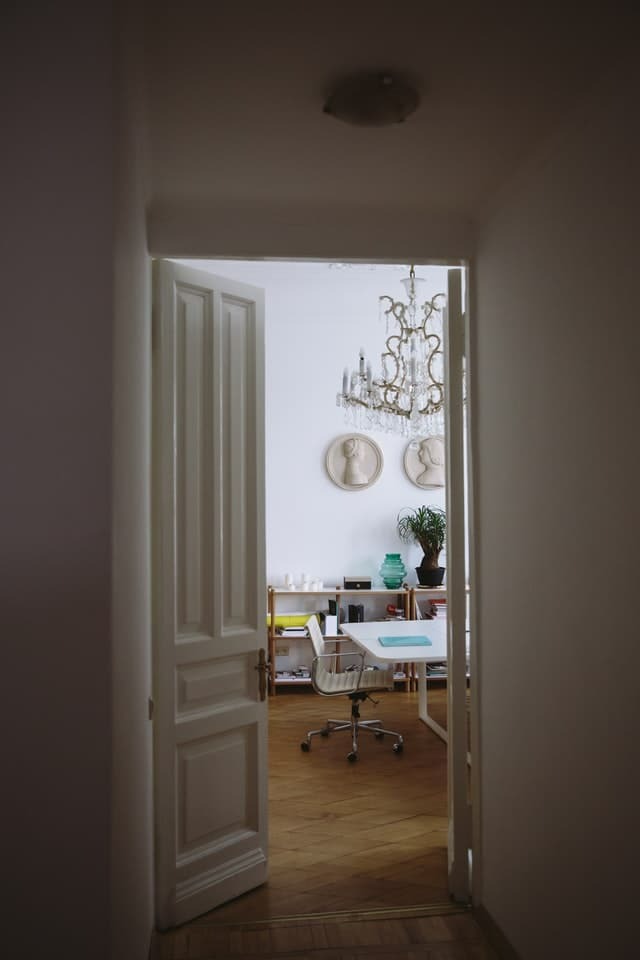
Like your walls, doors can fade over time into bland, colourless features that take away from the character of your home. Door painting can turn your old door into a statement piece, so we’ve made a simple step by step guide on how to paint a door. Building upon each step as you progress allows for easy to follow directions and clean, professional results.
However, you’ve probably noticed that not all doors are alike. Some doors have moulding with panels, or are constructed with stiles and rails. Others have glass inserts and different types of hardware.
Not quite sure about what colour to paint your door? Here’s a guide on How To Use A Colour Chart.
Door Paint Supplies & Materials You’ll Need
- Screw driver
- Paint Brush
- 4 inch Roller
- Saw Horses
- Drop Cloths
- Painter’s Tape
- Wood Filler
- Sand paper
- Primer
Read more about the tools needed for painting here.
How to Paint Doors Step 1 – Prepare Your Surface
While some people paint their doors while still on the hinges, we recommend preparing your surface removed from it’s door frame. Ensure you have a saw horse or other raised platform before you begin door painting:
1) With a screwdriver, remove the door knob, hinges and locks and place your door on sawhorses. Proceed to place drop sheets underneath the door to protect the flooring.
2) Use wood filler to patch any holes in the door’s surface, wait to dry and then lightly sand your door’s surface using fine-grit sandpaper (220). Once smooth, wipe with a damp cloth before moving on to the next step.
Step 2 – Prime Your Door
Primer is required if you’re using latex paint to paint over your oil-based painted door. To find if your door is oil-based, rub the surface with a clean rag moistened with alcohol. If paint comes off onto the rag, your door is latex-based and if it remains, it’s oil-based. With the right paint in hand, you’re ready to begin door painting.
Step 3 – Door Painting
Conventional means for door painting would be to start from top to bottom, but for a 6-panel door, we recommend painting in the following order:
1) With a narrow paintbrush, apply paint around your door’s edges. Brush in one direction to avoid painting the same spot twice.
2) Next are your door panels. Use your roller to paint the flat panel surface and a fine brush for more minor areas like moulding.
3) Paint your door’s middle vertical strip between panels in an up and down motion with your roller. Right after, proceed to paint your horizontal strips.
4) Roll paint on the remaining vertical strips on your door’s outer sides. And for a smooth and professional-looking paint finish, always roll in the direction of your wood grain.
Step 4 – Apply Your Second Coat
1)Once you’ve applied your first coat, leave your door to dry for 30 minutes to an hour. Proceed to lightly sand your door’s painted side with 320 grit sandpaper. Here’s more on How Long You Should Wait Between Paint Coats.
2) Apply your second coat of paint and wait another two hours.
3) Flip your door and repeat the previous steps. Hang your door back to its proper position with hardware fully installed.
Want to renovate other areas in your house with ease and precision? Read our painting bathroom guide and our window frames painting guide to begin today!.
Door Painting FAQ
Is it better to paint a door with a brush or roller?
Both tools are recommended when painting your doors. Painting doors with a roller is more efficient for flat surfaces like its border for a leveled finish. Meanwhile, you can use a paintbrush for your door’s edges and angled, more intricate areas like moulding.
Can you paint a door while hung?
If you’re having difficulty removing your door from its hinges, you can paint them while hanging. However, you may require a step ladder to paint hard-to-reach areas like your door’s upper edge.
How to paint a door without brush marks?
First, ensure your door’s surface is smooth via sanding before painting, doing so between paint coats. Once you’ve achieved your desired finish without bumpy areas, use a roller to apply paint in the same direction as your wood grain.
Paintbrush users should use gentle to medium pressure during application with a thin coat of paint. And like a roller, always paint in one direction with your wood grain.
Do you use semi-gloss on doors?
Semi-gloss is typically applied for doors, trims and household cabinets and is considered the best paint for doors. While not as glitzy and shiny as an entirely glossed finish, it’s easy to clean and can stand up to wear and tear like scuff marks, scrapes and excess moisture. Because fully-glossed surfaces are highly reflective, they emphasise imperfections more so than surfaces with less sheen.
Semi-gloss makes a good compromise between flat paint and gloss, retaining its shine without showing obvious signs of damage. Here’s a guide on How To Choose The Right Paint that you might find useful.
How to paint a door with a roller?
A foam roller is best when painting a plain, flat door without any raised design or detail. When rolling paint, it’s essential to leave no roller lap marks if you want a smooth surface. Do so by adding less paint to your roller (an overloaded roller causes roller lines) and going over your door’s wet coat until you have an even surface.
Painting doors with a roller will give you a smooth finish, but brushwork will be required for your door’s edges and door frame.
Newline Painting – Qualified Door Painters in Melbourne
Painting doors is a multifaceted process that requires attention to detail. Ensure your work is professional by hiring qualified door painters from Newline Painting who complete all the paint work on your door, frame and molding for you.
Newline Painting is a professional painting business based in Melbourne that specializes in interior and exterior house painting services. Our painters are experienced, reliable and always go above and beyond to deliver high-quality results. Explore our website and contact us today for your free quote! Our area of coverage in Melbourne includes Berwick, Brighton East, Dandenong, Flemington, Mount Waverley, and Yarraville, among many others. Interested in reading more painting articles? Check out our metal paint removal guide and our MDF Painting Guide to learn more!







